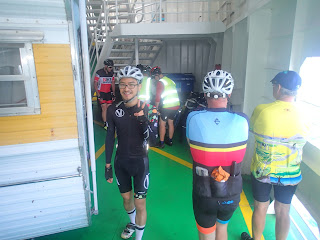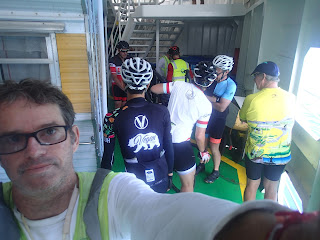 |
| Problems with Roll Down Tests: Cars parked near the gutter means its hard to mark the stopping position of the bike accurately. |
 |
| More problems: For accurate results comparing aerodynamic setups (in this case wheels with covered spokes), conditions like tyre pressure, temperature and wind condition all need to be the same between runs. |
 |
| This is a composite of several screen grabs from this ride with gps post . It includes the on-screen square popups showing slope and height at different locations. |
Hi
For the last few days I've been doing roll down tests on trikes with different style wheels fitted. The aim was to see which wheels are the more aerodynamic or wind-resistance decreasing. I'm forced to admit I didn't really come up with worthwhile results in terms of the aerodynamics, but thinking about it and jotting down a few formulas has come up with some methods which might be useful. So here we go. I'm going to ask a few questions, see if I can answer them mathematically, then work out if measurements I've made make any sense.
IF I RIDE TO THE TOP OF A HILL AND THEN ROLL DOWN AGAIN WITHOUT PEDALLING, HOW FAST WILL I GO?
The answer depends on lots of factors, but its not hard to work out the fastest speed.
At the top of the hill when the cycle is at rest, the potential energy is MgH where M is the combined weight of cycle and rider, g is the gravitational constant of 9.8 m/(s^2) and H is the height of the hill. Without pesky wind and rolling resistance, all that potential energy is converted to kinetic energy
( ( 0.5*M*(V^2)) where V is the velocity at the base of the hill.
We want to end up with V expressed in km/h, and not some other silly units like m/s or miles/h.
First lets simplify the equation MgH = 0.5*M*V^2
to get g*H = 0.5 * V^2
or V(m/s) = (9.8 * 2 * H(m^2/s^2))^0.5
or V(km h/3.6) = (9.8 * 2 * H(m^2/s^2))^0.5 or
or V(km/h) = ((9.8 *2)^0.5) * 3.6 * H^0.5
or V(km/h) = 15.9 * H(m)^0.5
With my own trials and speedo with maximum speed function, I got up to 54 kph going down the slope shown in the third pic. Does this make sense?
Well it seems to! The calculated maximum top speed is 15.9 * 29m ^ 0.5 or 85.6 km/h, and I reached 54km/h, so it seems plausible the rest of the speed was lost to air and rolling resistance.
Before adding to this bit of maths, I thought I'd clarify what I'm trying to do here and made the diagram shown below.
 |
| Cycle Performance Improvement Map |
The whole thing can be labelled Cycle Performance Improvement Map. It doesn't take everything into account, for example adding mudguards will add weight and may worsen aerodynamic drag but still improve performance. The tests I'm doing here are seeking some justification for cycle mods in the C5 cell of the diagram, that is showing that improving aerodynamics while increasing weight slightly is sensible.
HOW TO SHOW THAT IMPROVING CYCLE AERODYNAMICS WHILE INCREASING CYCLE WEIGHT STILL IMPROVES CYCLE PERFORMANCE.
The method I propose is to perform an energy balance by quantifying:
A: The energy expended by lifting an aerodynamic cycle accessory up a hill. This is actually the difference in potential energy between "bike plus rider plus accessory" and "bike plus rider".
This works out at mgH where m is the weight of the accessory, g is acelleration due to gravity and H is the height of the hill.
B: The gain in energy achieved by the accessory giving extra speed during coast-down on the same hill.
This works out at Mgh where M is the weight of the "bike plus rider plus accessory", h is the difference in height achieved during roll down tests and g is acceleration due to gravity.
To reckon that we have improved things we want an energy gain from the process, that is
mgH < Mgh. "g" can be taken out to get
mH < Mh.
Now h is the height difference at the end of a downhill run, with and without the accessory installed and is in fact H1 - H2 (H1 with accessory, H2 without). This is the same as (X1-X2)sin S where X1-X2 (call it X) is the distance apart in metres of the stopping points with and without the accessory and S is the angle in degrees of the slope. With these new variables plugged in we get
mH < MXsin(S) or
We can divide everything by mH to get an Energy Gain Ratio figure
Energy Gain Ratio = (MXsin(S)) / mH and
For Energy Gain Ratio > 1, the accessory is demonstrably "worth it" in gross energy terms when ascending and descending the hill, but there are some provisos. For example, your peak energy output of the entire course could be when climbing the hill, and adding to that burden might not be helpful even if there are overall energy gains.
MORE LATER, I WILL TRY TO PROVIDE SOME WORKED THROUGH EXAMPLES NEXT TIME.
Meanwhile
here is a link to an article (p16) about a Lightning Recumbent that seems relevant.
Regards
Steve Nurse








































